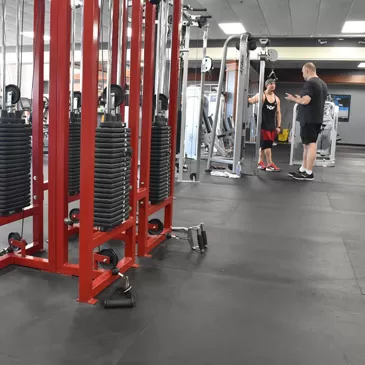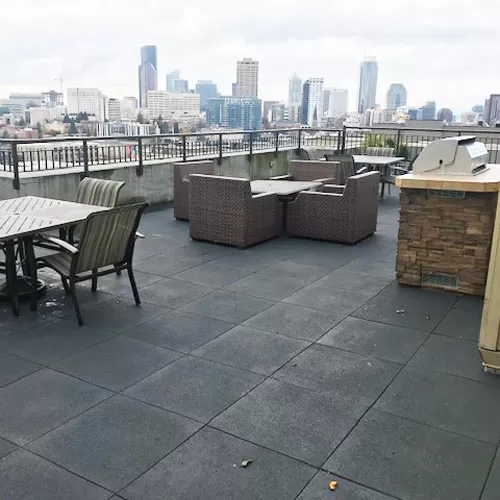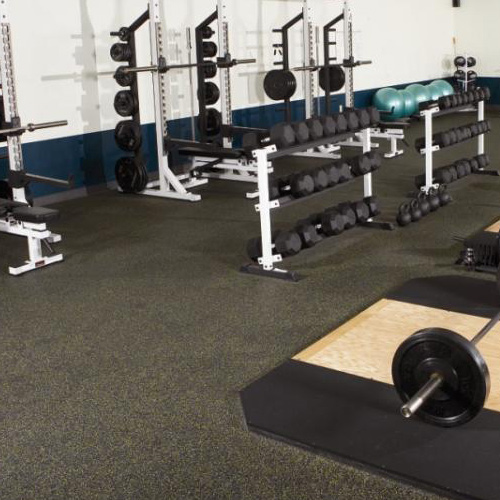How to Install Rubber Gym Flooring on Concrete & Other Surfaces
Related Product: Rubber Flooring Rolls Geneva 1/2 Inch Black Per SF
At Greatmats, we want you to be fully informed on the uses and advantages of each flooring type so you can make a confident, accurate decision. With that in mind, let's look closely at rubber flooring to see if your space would be enhanced by this surface material.
Best Conditions for Installing Rubber Flooring

Rubber flooring rolls can be laid in many different areas, but in general you'll find that flat, dry, indoor spaces are best for rubber floors. Rubber is flexible and bendable, yet it can be stiffer than other products, so if you have uneven concrete spaces, cracks, or gaps, it can create bulges and ridges on the flooring.
Rubber mats and rolls also work best in a dry area, specifically underneath. While they do not absorb water, moisture underneath can create mold and mildew growth, which means perforated tiles are better for wet areas.
Flat, dry, and hard; those are generally the best conditions for installing your rubber home gym floor over concrete.
Subflooring for Rubber Gym Floors
 One of the most important questions we get about rubber flooring revolves around subflooring. For good reason, our customers want to know when they need to use subflooring, and if so, which type they should use.
One of the most important questions we get about rubber flooring revolves around subflooring. For good reason, our customers want to know when they need to use subflooring, and if so, which type they should use.
One of the reasons to use subflooring is to protect the surface underneath. For example, if you are laying rubber floors over ceramic tile, you need a subflooring to keep the tiles from cracking or breaking. In many cases, a protective, cushioning surface is preferred when laying rubber over ceramic tile.
Likewise, if you are laying over hardwood, you should also have a subflooring. In this case, however, we recommend a layer of craft paper. Why paper? Because the black coloring of rubber mats and rolls can seep into hardwood, staining the material. Rubber can also react with some wood finishes. A layer of paper will keep the hardwood protected from staining and reaction so you have a gorgeous surface if you decide to remove the rubber.
You may also need a subflooring if you are installing rubber gym flooring over concrete slabs that contain moisture or have moisture underneath. In this case, the layer is to keep water from becoming trapped beneath the floor.
In all cases, it's important to talk with our live support staff to see if subflooring is needed.
When Should Rubber Flooring Be Avoided?
Rubber flooring is very versatile and reliable, but there are some areas where you should avoid using it. In almost all cases, you will want a flat, even surface. Rolled rubber can contour to ridges and inconsistencies, but this is not ideal for permanent placement, as it will result in bulges and wrinkles when installing rubber home gym floor over concrete if the concrete is not flat.Another time to avoid rubber floors for gyms is when the surface has significant gaps. For example, decking, which has gaps between the deck boards, is not a good location for rolled rubber flooring, as you will have ridges and seams in the floor. Similarly, tile floors with deep grout gaps are also not the best for rolled rubber flooring.
If you must use rubber in any of these situations, a thick tile or mat is recommended.
Installing Rubber Floors Over Different Surfaces

1. Flat Concrete
Of all the potential surfaces for installing rubber, a flat concrete surface is probably the most ideal. Rubber gym flooring installed over concrete that is flat provides a consistent, long-lasting foundation, which creates great long-term quality. Rubber floors for gyms require a solid, level surface, and concrete is nearly perfect for this need. However, you want to make sure that there is not a high level of moisture within or underneath the concrete, as this can seep upward, become trapped between the concrete and rubber, and cause mold problems. If there is moisture, a full-spread adhesive will act as a waterproofing measure for your home gym flooring over concrete installation.
Indoors, rubber is an excellent product, even for damp areas like jacuzzis or indoor pool decks. However, there are better options for outdoor pools and hot tubs.
While rolled rubber flooring is perfect for flat concrete slabs, it must be glued down if you are installing it over concrete steps. When placed over steps, it can shift and move underneath your foot, creating a potentially dangerous safety hazard. Therefore, it's better to use an adhesive to keep the rubber flooring in place.

2. Ceramic Tile
Another surface that is good for rubber flooring is ceramic tile, but because of the fragile nature of these materials, it may be necessary to include some sort of protection and subflooring. Even the best ceramic tiles can be brittle when used for heavy foot traffic or if weights are dropped, so it's possible to damage the tile if you only use rubber flooring - especially a thinner version.
If you install rubber floors over ceramic tile, you may notice some follow-through. You could also see grout lines through the rubber flooring, especially if the grout is significantly deep in between the tiles.
Despite the challenges, ceramic tile remains a popular choice for flooring surfaces. It may require a subflooring or padding to protect the tiles or prevent lines or creases, but our helpful staff can work with you to select the right flooring and accessories to make your floor look fantastic, all while protecting the ceramic tile underneath.

3. Flat Hardwood
Hardwood is one of the most gorgeous, elegant, and attractive surfaces you can have in your home or office. However, if you need to cover hardwood, rubber flooring is actually a great choice. But there is a condition: rubber floors over hardwood require a protective paper underlayment, especially for high-quality hardwood.
For all rubber flooring products, we recommend a craft paper underlayment. This underlayment performs one important task: it keeps the black coloring of the rubber from staining the hardwood. With the paper underlayment, there is no transfer of color, so if and when you decide to lift the rubber flooring, you still have an elegant, warm wood surface.
While rubber flooring can be great for indoor hardwood floors, it is not the best option for covering outdoor wood decks. To get the best results for a wood deck, modular perforated tile is a superior option, as it allows rainwater to drain underneath, as it would between the gaps in decking.
Rubber is also not ideal as a temporary protective surface for large gym floors due to its weight. In this case, we recommend a protective vinyl sheet. We offer 10-ounce to 27-ounce weight sheet vinyl that is designed specifically for large gym floor coverings. This product is usually the best option for basketball, volleyball, and racquetball courts, as well as school or community-center gyms.

4. Carpet
We do not recommend using rubber mats or rolls over carpet. When you place rubber rolls over carpeting, the material will bunch up, creating tripping hazards and giving the surface an inconsistent, ugly appearance. Rubber can also cause damage to carpet, creating more problems for your flooring.
So if rubber flooring should not be used for carpet, what is a better option? In most cases, we recommend a raised interlocking tile that gives good grip between the carpet and the surface material. With interlocking tiles, especially ones that are made from harder plastics, there is less chance of bunching and other issues. We also have 9/16-inch thick PVC tiles that are excellent options for use over carpet.

5. Outdoor Surfaces (Grass, Dirt, Rock, Etc.)
Using rubber rolls over ''natural'' outdoor surfaces, such as grass, rock, and dirt, is not recommended. Because rubber rolls are not perforated, they will keep water on top, so if it rains on a rubber roll, the water will stay put, unless, of course, there is a slope that allows for drainage. Essentially you'll have water pooling and puddling on top, which can be a nuisance.
You could conceivably use rubber flooring on grass, rock, or dirt as an individual roll as a temporary runner. However, this is still not the best option.
If you need rubber for your outdoor home gym, we have many outdoor flooring options that provide the traction and support you are looking for in tile or paver forms.

6. Rooftops
We sometimes get questions about rooftop home gym flooring over concrete and rubber membrane surfaces. Many people want to turn their outdoor rooftop into a usable space. Assuming the structure has enough strength and integrity for foot traffic, there are a few options, but rubber flooring rolls are generally not recommended.
One of the main issues of using rubber flooring over rooftops, especially concrete rooftop surfaces, is mold. Mold is most often found in damp areas where water has been trapped. When you lay down rubber mats or rolls over a concrete surface, you create the perfect location for mold. Laying a flat rubber product over a membrane is likely to cause mold, which is why we do not recommend rolled rubber flooring for rooftop surfaces.
Like most outdoor areas, it's best to have a perforated top or other method for drainage, which allows water to move underneath, provides conditions for evaporation, and results in less chance for mold.
If you're set on a rubber surface for your rooftop patio, 2 inch thick Sterling Roof Top Tiles are your best option, as they feature a raised base. However, proper drainage precautions should be taken in the sub-surface as these rubber tiles are porous in nature.
Find the Perfect Flooring for Any Surface
Do you have a unique surface that you need to cover? Please contact our friendly staff, and we'll reach out to you with more information about all our fine products. We have the knowledge and experience to provide accurate advice on your specific flooring needs, so contact us today!
Rubber Flooring Installation Video
Installing rolled rubber is a simple process. All you need is a sharp utility knife, a T-square as a cutting guide, and a roll of double-sided tape.- First, you clean the subfloor.
- In order to square off the roll ends, cut the material square.
- In a wall-to-wall application, you'll want to start at one end of the room and work your way to the other.
- When you reach the opposite wall, cut the roll to fit. Work slowly and be careful not to cut too much away.
- The rolls are cut to fit tightly, side by side. Simply roll the next roll beside the first one and cut accordingly.
- This is done by measuring the distance between the wall and the edge of the last roll you've applied.
- Measure a few locations to make sure your wall is straight.
- With a straight edge, draw a line, then run your utility knife along the straight edge.
- Now that the pieces are cut to fit, apply the double-sided tape around the perimeter of the room and at the seams.














